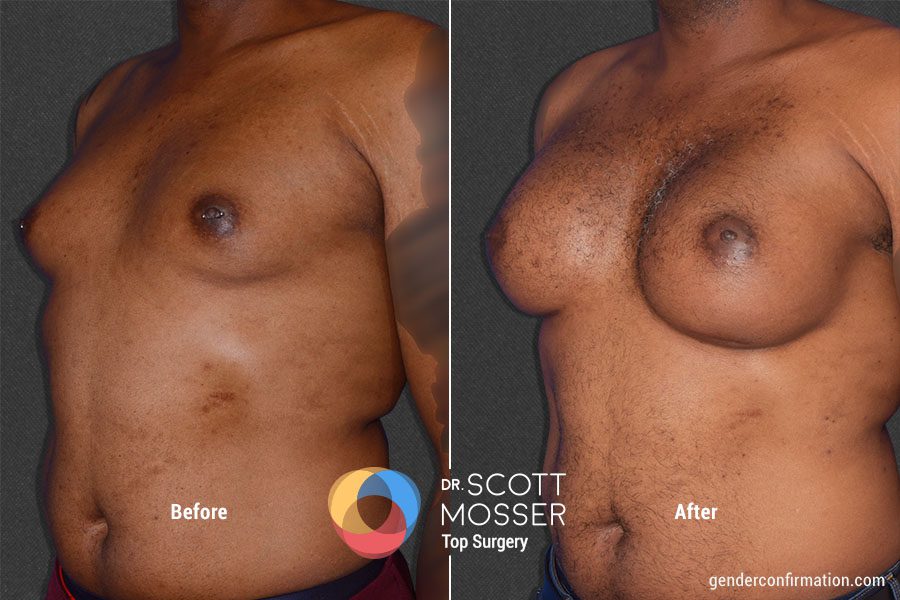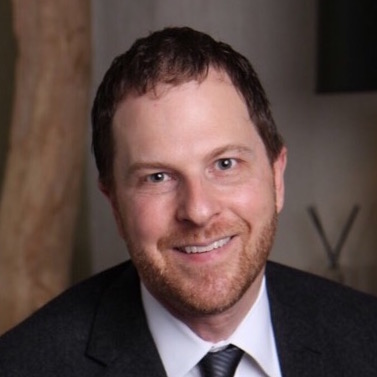Your Questions Answered: Breast Augmentation for Transgender and Non-Binary Patients
Medically reviewed by Dr. Scott Mosser on March 13, 2024.
Finally, a group of expert top surgeons inclusive of all identities and body types, with a highly successful insurance concierge.
This page is our homebase for gender-affirming breast augmentations– sometimes called “male to female (MTF) top surgery” or “male to female/non-binary (MTF/N) breast implants.” We know that patients can feel confused about how to get surgery and overwhelmed as they prepare for it. To help simplify the process, we have compiled information and resources for you on the following topics:
On This Page
What is a gender-affirming breast augmentation?
Which option is right for me? Techniques and top surgery scars
Gender-affirming breast augmentation encompasses a variety of ways to enlarge or construct breasts: principally through implants or liposuction-fat grafting. Transgender and non-binary patients often have different needs than cisgender women seeking breast augmentations. For example, wider breast implants and specific placement techniques may be necessary to help a trans patient meet their goals due to common anatomical factors (e.g., chest width, the space between nipples, etc.). For this reason, we encourage patients to consider board-certified surgeons who are specialized in working with trans patients.
At the GCC (Gender Confirmation Center), we have performed over 4,000 gender affirming procedures since 2009 using state-of-the art medical technology. In an effort to make the safest, highest quality surgical care financially feasible, our insurance concierge service has successfully secured insurance coverage for 90% of interested patients. At the GCC, we are unique in our commitment to making gender-affirming surgeries accessible to patients of all gender identities, regardless of hormone usage, body mass index (BMI), age or disability.
If you are interested in surgery, you can request a free, virtual consultation with us today. If you have questions about recovery or complications and revision surgeries, you can click on the hyperlinked articles.
You can read more about what unique considerations our practice has for trans patients below. If you are interested in surgery, you can request a free, virtual consultation with us today.
-
 Augmentation type: fat grafting vs. saline & silicone implants
Augmentation type: fat grafting vs. saline & silicone implants -
The fat grafting technique is less common because of its low success rate when a large amount of volume is needed and the skin is particularly tight. This means that the first choice for most patients is between silicone and saline implants. Fat grafting can be used in addition to implants, for example, to increase cleavage.
Silicone implants have become the most popular choice because of their durability, softer feel and appearance, especially for those without a lot of breast tissue.
-
 Implant shape
Implant shape -
From there, a patient can choose the shape of their implants. At the GCC we prefer round or circular to teardrop-shaped implants so that rotation does not pose a risk to breast symmetry. Likewise, circular implants allow for more options around placement and a smaller incision for insertion, which reduces the size of the scar. Specialists in transgender care will know that trans patients will often need wider implants than their cis counterparts to meet their goals.
-
 Breast size
Breast size -
Rather than measuring by cup or bra size, the size of breasts are determined by the implant size, which typically ranges from 200cc-500cc. The final appearance of your breast size will have a lot to do with your unique anatomy. We encourage patients to try out the rice bag test at home to figure out which size would best suit your needs. Likewise, during an in-person consultation we allow patients to try on implant sizers.
-
 Top surgery scars
Top surgery scars -
Your surgical scars are determined by the incision location or where the breast implant will be inserted. Patients main concerns are around minimizing scar visibility and creating an incision that allows for optimal implant placement. For these reasons, we most commonly perform an inframammary fold, which conceals the scar at the fold at the bottom of the breast. Scar visibility can often be reduced with proper care.
Patients can also opt for an incision along the border of the areola (periareolar) or through the armpit (transaxillary). Most transgender patients we see do not have large enough areolas to insert a silicone implant. Although the scar is hidden, inserting implants through the armpits is associated with higher rates of capsular contraction, bleeding and placement complications.
When it comes to aftercare, each surgeon will give you their own recommendations based on their experience and preferences. Dr. Jacobs (he/him), for example, recommends compression over all other care techniques. Still, patients should follow other care protocols like being careful not to expose their scars to UV rays during the first year after recovery.
-
 Implant placement
Implant placement -
Placement refers to the option to place the implants below the muscle (submuscular) or above the muscle and below the mammary glands (subglandular). You can read more about the advantages and disadvantages of each, along with the option to score the muscles above a submuscular implant here.
If you have questions about which techniques would help you best achieve your goals, you can book a free, virtual consultation with one of our board-certified surgeons.
Create a unique surgical plan based on your goals, body type and medical history. Have all your doubts about surgery answered; no question is too trivial or too personal.
There is a lot that goes into preparing for top surgery, which can make it confusing and even overwhelming for some. The information below is meant to help guide you on the steps most patients go through before scheduling their surgery date. Once you have your surgery date, you can also consult this guide on how to prepare for your operation.
-
 What are the steps involved in getting breast implants?
What are the steps involved in getting breast implants? -
From requesting a consultation, to obtaining insurance approval and completing all other preoperative requirements, we have you covered with our top surgery timeline guide.
-
 Will my insurance cover this surgery?
Will my insurance cover this surgery? -
You can leave the insurance worries to us. The GCC provides a free insurance concierge service to interested patients. After soliciting any necessary documents from you, our insurance advocacy team will get to work to secure full or partial coverage for your medically necessary, gender affirming procedure(s). Our team has a 90% success rate in securing coverage for insured patients. Learn more about those services here.
-
 How can I finance my surgery if it’s not covered or only partially covered by insurance?
How can I finance my surgery if it’s not covered or only partially covered by insurance? -
We have compiled a list of scholarships for gender affirming surgeries alongside trusted, medical credit agencies you can use to help finance your surgery with us. You can also find estimated costs for each procedure we offer if you plan on paying entirely out of pocket. Click here for more.
-
 Do I need a letter of approval from a therapist, psychiatrist or primary care doctor to get top surgery with GCC?
Do I need a letter of approval from a therapist, psychiatrist or primary care doctor to get top surgery with GCC? -
Letters of support or clearance letters from certified, mental health professionals are welcome and valuable, but not a requirement for adults who seek surgery with the GCC. This is because we use the informed consent model, which means that a letter from a therapist is not required unless the patient is seeking insurance approval.
Insurance companies always require a letter of support from a mental health professional. Additionally, if our surgeons are outside of your provider network, you will need a reference letter from your primary care provider to request insurance coverage. For more information, click here.
-
 What about patients who are traveling from out of town to San Francisco for surgery?
What about patients who are traveling from out of town to San Francisco for surgery? -
Many trans, non-binary and gender expansive patients need to travel to access quality, reliable gender affirming surgical care. At the GCC, we are very accustomed to working with patients from out of town. For recommendations on travel and lodging, click here. We have also compiled a guide on preoperative consultations and post-operative follow-up protocols for patients who do not live in the San Francisco Bay Area.
-
 Do I need to be taking hormone replacement therapy (HRT) to get top surgery?
Do I need to be taking hormone replacement therapy (HRT) to get top surgery? -
Absolutely not. At the GCC we are committed to serving patients of all gender identities. We only require HRT for patients undergoing certain bottom surgery procedures. We take an individualized approach with our patients to design a surgical plan that meets their unique goals.
-
 How long should I be on HRT before getting a breast augmentation?
How long should I be on HRT before getting a breast augmentation? -
Generally, patients who are taking estrogen and/or progesterone HRT are recommended to let their breast tissue develop for at least a year under treatment. Doing so can maximize breast augmentation results. That said, we have no HRT requirements to undergo this surgery. Likewise, we have had successful results with patients who come in with no initial mammary tissue.
-
 Can a breast augmentation be performed alongside other procedures like body feminization surgery?
Can a breast augmentation be performed alongside other procedures like body feminization surgery? -
The most common procedure to accompany a breast augmentation is body feminization surgery or gender affirming body contouring. You can learn more about trunk and arm liposuction as well as fat grafting options like a Brazilian Butt Lift (BBL) and hip dip fat transfer here.
-
 How can I best prepare for breast augmentation?
How can I best prepare for breast augmentation? -
We have prepared a guide specifically for breast augmentation patients on how they can prepare for surgery in the days leading up to it. Additionally, exercise and drug consumption are two of the most important factors to monitor before your surgery that can help you maximize your results and speed up your healing process. Learn more about our guidelines and recommendations around exercise and drug use here.
-
 Will the sensation in my breasts and nipples change after top surgery?
Will the sensation in my breasts and nipples change after top surgery? -
All of the breast implant options we offer involve a risk of sensation loss. While most patients report an overall loss in sensitivity of their breasts and nipples post-op, they tend to report higher levels of sexual satisfaction because of feelings of euphoria and alignment with their bodies. You can read more about this topic here.
-
 Do implants impact breast cancer risk?
Do implants impact breast cancer risk? -
So far, there is little evidence linking saline or silicone breast implants to an increased risk for breast cancer. Otherwise, for patients who have developed breast tissue through hormone replacement therapy (HRT), there is some evidence to suggest that it can increase your breast cancer risk. As a result, it is recommended that if you are over the age of 50 and have been undergoing HRT for 5 or more years, you undergo screening mammography every 2 years. Additionally, there is a type of lymphoma that is associated with breast implants. Read more about risk evaluation and best practices for breast cancer detection in transgender patients here.
-
 Is it important to see a surgeon who specializes in transgender patients?
Is it important to see a surgeon who specializes in transgender patients? -
The techniques used for a breast augmentation are the same regardless of a patient’s gender identity. That said, surgeons who are not experienced working with transgender patients may not have the expertise to determine how to best help a patient achieve their goals given their body’s proportions due to the puberties or puberty they have undergone. For more information, click here.
-
 Dr. Ellie Zara Ley (she/her/they)
Dr. Ellie Zara Ley (she/her/they) -
Dr. Ellie Zara Ley (she/her/they) is a board-certified plastic surgeon and the only transgender woman of color to offer a full-spectrum specialization in gender affirming surgery: top surgery, bottom surgery, facial surgery and body contouring. She also specializes transgender adolescent care. She is highly trained, having completing her general surgery residency at University of Arizona, a fellowship in plastic and reconstructive surgery at the University of Utah, a fellowships in craniofacial and pediatric plastic surgery at Primary Children’s Hospital in Salt Lake City and another in hand surgery and microsurgery at the University of Southern California. Prior to joining our team in 2022, she worked as an assistant clinical instructor of plastic surgery at the University of Utah and had her own private practice in Arizona.
-
 Dr. Alexander Facque (he/him)
Dr. Alexander Facque (he/him) -
Dr. Alexander Facque (he/him) is a board-certified plastic surgeon and proud member of the LGBTQ+ community. Dr. Facque got his start in gender-affirming care as a resident at the Icahn School of Medicine at the Mount Sinai Medical Center in New York, where he first recognized the importance of providing safe and accessible surgeries to trans and non-binary patients. He then spent a year training and expanding his knowledge under Dr. Loren Schechter, one of the world’s foremost gender-affirming surgeons, as a fellow at Weiss Memorial Hospital’s Gender Confirmation Surgery and Practice Leadership in Chicago. Dr. Facque officially joined our team in 2020 and brought with him over 5 years of previous experience in gender affirming care.
-
 Dr. Scott Mosser (he/him)
Dr. Scott Mosser (he/him) -
Dr. Scott Mosser (he/him) is a board-certified plastic surgeon who has over 15 years of experience serving gender diverse patients. He has devoted himself exclusively to gender affirming care since founding the GCC in 2013. Dr. Mosser is also a cofounder of the American Society of Gender Surgeons (ASGS), a member of the American Society of Plastic Surgeons (ASPS), the World Professional Association of Transgender Health, (WPATH), the United States Professional Association of Transgender Health (USPATH), and is a Fellow of the American College of Surgeons (FACS).
Do you have specific questions about top surgery? You can get them answered and start the journey to getting top surgery by requesting a free, virtual consultation with one of our board-certified surgeons today.
Request a Free Surgical Consultation Today.
All virtual and in-person consultations with our board-certified surgeons are free. Once you fill out this form, our patient care team will reach out and guide you through every step to get to surgery.










